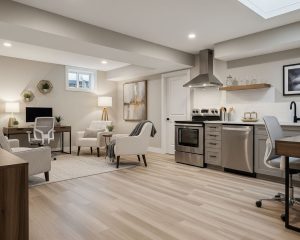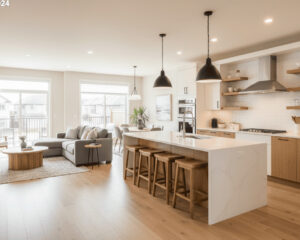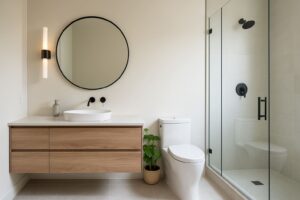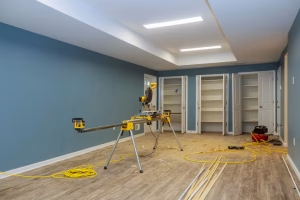Choosing the right bathroom flooring options matters more in Edmonton than many homeowners realize. Below-grade spaces, freeze-thaw cycles, and seasonal humidity swings affect materials differently. This guide explains durable, moisture-resistant bathroom floor choices that work well in Edmonton homes, including specific approaches for basement bathrooms over concrete and how to prepare, install, and maintain each option. We also explain permit and subfloor considerations and how Steadfast Constructions Ltd. helps Edmonton homeowners select and install the best floor for their needs.
What to consider for Edmonton homes
When evaluating bathroom flooring options, focus on four practical criteria that matter in Edmonton’s climate and housing stock:
- Moisture resistance and vapour control: Basements and bathrooms are moisture-prone spaces; selecting materials and detailing vapour control is essential. CMHC
- Durability and slip resistance: Choose floors that stand up to daily use, cleaning, and variable humidity.
- Thermal comfort and compatibility with subfloors: Concrete slabs and below-grade floors can feel cold; some floor systems include thermal breaks or work well with underfloor heating.
- Ease of maintenance and long-term performance: Low-maintenance options reduce long-term issues, especially in second-bath or basement suite scenarios.
These priorities narrow choices to a handful of practical families: porcelain/ceramic tile, luxury vinyl (planks and tiles), engineered wood and waterproof wood alternatives, modular raised systems, and specialty finishes like epoxy or sealed concrete. Authoritative reviews and industry guidance emphasize waterproof performance and installation methods appropriate to the substrate. Better Homes & Gardens
Porcelain and ceramic tile
Porcelain and glazed ceramic tile remain industry standards for wet areas because they are dense, non-porous when glazed, and easy to clean. Porcelain, in particular, has a very low water absorption rate and performs well in showers, wet rooms, and high-traffic bathrooms.
Why tile suits Edmonton:
- It handles moisture and humidity without degrading.
- Large-format or rectified tiles can reduce grout lines and simplify cleaning.
- Tile pairs well with a heated slab or electric underfloor heating to offset the cold feel of concrete subfloors.
Installation considerations:
- Proper underlayment and a quality thin-set with a polymer-modified adhesive are essential.
- For basement bathrooms over concrete, address vapour movement and use an appropriate membrane or uncoupling layer to protect tile and grout from moisture-related problems. CMHC guidance on moisture control and finishing basements underscores the importance of solving moisture sources before finishing. CMHC
Who should choose tile:
- Homeowners who want a long-life, water-resistant finish and design flexibility.
- Spaces where a truly waterproof surface is a priority.
Luxury Vinyl Plank and Vinyl Tile
Luxury vinyl plank (LVP) and vinyl tile offer a compelling balance of water resistance, realistic finishes, and comfort underfoot. Modern vinyl is designed to be fully waterproof in many formats, and sheet vinyl provides a seamless surface that minimizes water penetration at seams.
Why vinyl suits Edmonton:
- It tolerates seasonal humidity changes and is suitable for basement bathrooms over concrete when paired with a proper vapour barrier and level substrate.
- Vinyl warms better than tile on bare concrete and is generally quieter underfoot.
Installation considerations:
- Ensure the concrete slab is clean, level, and free of moisture issues before installing. Some vinyl types are installed loose-lay or with adhesives; follow manufacturer guidelines for below-grade installs.
- Use transition details where the vinyl meets adjacent flooring and ensure door clearances are adequate to avoid buckling.
Who should choose vinyl:
- Homeowners seeking a warm, resilient surface that mimics wood or stone without the maintenance concerns of natural materials.
Engineered wood and waterproof wood alternatives
Traditional hardwood is vulnerable to moisture, but engineered wood and certain waterproof wood-look products are engineered to be more dimensionally stable. Some high-performance engineered floors pair with waterproof cores and can be used in bathrooms if installed with careful detailing.
Why consider them:
- They provide the look of wood with greater resistance to humidity and seasonal movement.
- When combined with proper underlayments and edge sealing, engineered floors can work in main-floor bathrooms.
Installation considerations:
- Avoid installing floating wood floors directly over damp concrete without a suitable subfloor or membrane.
- Choose products rated for wet-area use and follow the manufacturer’s warranty conditions.
Who should choose engineered wood:
- Homeowners prioritize a warm, natural aesthetic on main-floor bathrooms, with careful attention to ventilation and maintenance.
Modular raised flooring systems and interlocking tiles
Raised, interlocking modular floor systems create a ventilated gap between the concrete slab and the finish layer. These systems are particularly useful for basement bathroom flooring options over concrete, where a vapour barrier and air circulation can prevent trapped moisture.
Why raised systems suit Edmonton:
- They allow airflow under the finish, reducing the risk of trapped moisture damaging finishes.
- They provide some thermal isolation from cool slabs and simplify repair or replacement.
Installation considerations:
- Raised systems are typically installed as floating floors and can accept a variety of finish surfaces, including engineered flooring, laminate, or modular tiles.
- Ensure load and plumbing penetrations are planned so service access and drainage are maintained.
Who should choose raised systems:
- Homeowners renovating a basement bathroom with known slab moisture concerns who want a removable, resilient solution.
Sealed concrete and epoxy finishes
Sealed concrete or decorative epoxy can provide a seamless, low-maintenance bathroom surface that tolerates moisture. Epoxy coatings create a durable, continuous surface and are often used in utility or modern-style bathrooms.
Why these finishes work:
- Seamless finishes reduce places for water to penetrate and simplify cleaning.
- They pair well with contemporary design schemes and can be applied over properly prepared concrete.
Installation considerations:
- Surface preparation is critical; concrete must be dry and well-prepared to ensure adhesion.
- Epoxy may be slippery when wet; choose textured finishes or integrate slip-resistant additives in busy bathrooms.
Who should choose sealed concrete or epoxy:
- Homeowners seeking a modern, seamless floor solution and who have a sound slab or are finishing a slab-on-grade area.
Carpet and carpet tiles: When they belong
Carpet is generally discouraged for primary wet bathrooms due to moisture and mould risk. However, in some basement setups where a separate shower or utility area exists, specific carpet tiles designed for removable use or raised modular carpet squares can be considered for recreational or secondary areas, avoiding wet zones.
Why to be cautious:
- Basements and bathrooms can expose carpet to moisture that promotes mould and odour. CMHC guidance recommends avoiding carpets on damp slabs and addressing moisture sources before installing soft finishes. CMHC
Choosing bathroom flooring for basement bathrooms over concrete
Basement bathroom flooring options over concrete require extra attention to moisture, vapour migration, and a durable subfloor. Key best practices include:
- Diagnose slab moisture before selecting a finish. Use proper moisture testing if there’s any concern.
- Use a vapour control strategy: membranes, uncoupling layers, or raised systems help protect finishes and reduce the risk of adhesive failure or mould.
- Address drainage and sump or perimeter issues first; waterproofing the slab and perimeter drainage reduces long-term risk. CMHC resources on finishing basements stress solving moisture sources before finishing. Government of Canada Publications
Suitable basement finishes often include sheet vinyl, LVP with a vapour barrier, porcelain tile with a proper membrane, modular raised floors with a removable finish, or sealed concrete/epoxy where appropriate.
Slip resistance and safety
Slip resistance is essential in bathroom flooring choices. Look for finishes and tiles with appropriate surface ratings for wet areas, and consider textured finishes or small-format tiles with additional grout lines in shower floors for added grip. Add grab bars, non-slip mats, and consider heated floors to reduce condensation in colder months.
Maintenance and longevity
Different flooring types have different maintenance needs:
- Tile: periodic grout sealing, routine cleaning, and grout care.
- Vinyl: regular sweeping and damp mopping; avoid abrasive cleaners.
- Engineered wood: dry cleaning and careful protection from standing water.
- Raised systems: easy repairs and replacement of individual tiles or panels.
Routine ventilation, prompt water cleanup, and monitoring for early signs of moisture intrusion extend the life of any bathroom floor.
How Steadfast Constructions Ltd. helps Edmonton homeowners choose and install bathroom flooring
Steadfast Constructions Ltd. supports Edmonton homeowners through the full process:
- Site assessment and moisture diagnosis for basement slabs.
- Subfloor preparation, vapour barrier and membrane selection, and installation of uncoupling layers where appropriate.
- Advice on finishes that meet design goals and code/permit requirements in Edmonton.
- Coordination of trade work, underfloor heating, and final finishing to ensure long-term performance.
If you’re unsure which bathroom flooring option fits your home, Steadfast offers consultations that include substrate evaluation and a curated selection of finishes appropriate for Edmonton conditions.
Local example: finishing a compact basement bathroom in Edmonton
A central Edmonton bungalow required a compact basement bathroom upgrade where the concrete slab had occasional dampness. The project team tested the slab, installed a vapour membrane and an uncoupling layer, and used large-format porcelain tile with warm in-floor heating to offset the cold underfoot. The chosen approach addressed moisture risk, provided a durable surface, and met the homeowner’s aesthetic goals.
“Diagnose the slab first and build the floor assembly from the inside out. That approach reduces surprises and preserves finishes.”
— Liam Harper, Project Manager, Steadfast Constructions Ltd.
Decision checklist: choose the right bathroom flooring option
- Confirm whether the bathroom is main floor or below grade.
- Test and address slab moisture before selecting finishes.
- Choose waterproof or water-tolerant materials for wet zones.
- Match finish to desired look, maintenance expectations, and underfloor heating options.
- Confirm transitions to adjacent rooms and doorway clearances.
- Work with a contractor who prepares the substrate and follows the manufacturer’s installation guidelines.
Conclusion
Selecting the right bathroom flooring options for an Edmonton home starts with diagnosing moisture risk and matching material performance to the space. Porcelain tile, luxury vinyl, raised modular systems, sealed concrete, and carefully chosen engineered solutions each have places depending on whether the bathroom is main floor or in a basement over concrete. Prioritize vapour control, substrate preparation, and proper installation to protect your investment and avoid future problems.
Steadfast Constructions Ltd. helps Edmonton homeowners with thorough site assessments, permit-aware installations, and proven floor assemblies that perform in Edmonton’s climate. If you’re planning a bathroom upgrade or finishing a basement bathroom, contact Steadfast Constructions Ltd. for an assessment and a tailored recommendation for the best bathroom flooring options for your home.
Ready to choose the right bathroom floor for your Edmonton home? Contact Steadfast Constructions Ltd. to schedule a site assessment and get expert guidance on moisture-safe, long-lasting flooring solutions.
Frequently Asked Questions (FAQs)
Q1: What bathroom flooring options work best over a concrete basement slab?
A1: Options that work well over concrete include porcelain tile with a proper membrane, luxury vinyl plank or tile with a vapour-control strategy, modular raised flooring systems that ventilate the slab, and sealed concrete or epoxy finishes when the slab is dry and well-prepared. Always diagnose and address slab moisture before finishing.
Q2: Is porcelain tile better than vinyl for bathroom floors?
A2: Porcelain tile is a long-lasting, highly water-resistant option suited to very wet areas; vinyl offers waterproof options with warmer underfoot comfort and easier installation. The best choice depends on comfort preferences, subfloor conditions, and design priorities.
Q3: Can I install engineered wood or laminate in a bathroom?
A3: Some engineered wood products and waterproof wood-look alternatives are rated for bathrooms, especially on main floors. They require careful detailing, strong ventilation, and adherence to the manufacturer’s wet-area recommendations. Avoid traditional hardwood in wet areas.
Q4: How do I prevent mould or odour under bathroom flooring in a basement?
A4: Prevent mould by eliminating sources of moisture, improving exterior drainage, testing the slab for moisture, and using appropriate vapour barriers or raised floor systems. CMHC guidance stresses resolving moisture problems before finishing a basement.
Q5: Do I need a permit to replace bathroom flooring in Edmonton?
A5: Replacing finishes alone typically does not require a building permit, but work that alters plumbing, drainage, or electrical services does require trade permits. Check the City of Edmonton permit guidance and coordinate with your contractor if work affects plumbing or electrical systems.







